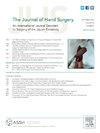National Trends of Surgical Interventions for Thumb Carpometacarpal Arthritis From 2010 to 2022
IF 2.1
2区 医学
Q2 ORTHOPEDICS
引用次数: 0
Abstract
Purpose
Thumb carpometacarpal arthritis is a common condition for which several surgical options are used: trapeziectomy with ligament reconstruction and tendon interposition (LRTI), other nonprosthetic arthroplasties without tendon transfer (eg, suture button suspensionplasty), trapeziectomy alone, arthrodesis, and prosthetic arthroplasty. The current study used a large, national, multi-insurance database to characterize utilization and factors associated with these surgical options over the years.
Methods
All adult patients who underwent one of the above-noted procedures were identified from 2010 to October 2022 using PearlDiver database. Patient characteristics were abstracted including clinical (age, sex, Elixhauser Comorbidity Index) and nonclinical (insurance plan, and geographic region) variables. Characteristics were compared with multivariable logistic regression to assess whether each influenced the odds of undergoing one procedure versus the others. Relative utilization of the different surgeries was assessed over the years of the study and changes in patient characteristics over time were compared with univariate linear regression.
Results
Of 160,387 patients identified, LRTI was performed for 97,595 (60.8%), other nonprosthetic arthroplasty for 46,371 (28.9%), trapeziectomy alone for 11,353 (7.1%), arthrodesis for 3,245 (2.0%), and prosthetic arthroplasty for 1,823 (1.1%). Various clinical and nonclinical variables were independently predictive of the surgery performed, the strongest being geographic region in which the surgery was performed. From 2010 to 2022, relative utilization, when compared with all other cohorts, only increased for nonprosthetic non-LRTI arthroplasty (from 27.1% to 35.7%, an absolute increase of 31.5%). Fewer cases of LRTI, trapeziectomy, arthrodesis, and prosthetic arthroplasty were performed (absolute decreases of 8.2%, 16.8%, 52.0%, and 44.9%, respectively).
Conclusions
Of surgical options to address thumb carpometacarpal arthritis, LRTI still predominates, but nonprosthetic arthroplasty was the only cohort increasing in utilization over the years. Both patient clinical and nonclinical factors were associated with receiving one surgical modality over the others.
Type of study/level of evidence
Therapeutic II.
2010 - 2022年拇指手掌骨关节炎手术干预的全国趋势。
目的:拇指腕掌骨关节炎是一种常见的疾病,有几种手术选择:梯形骨切除术联合韧带重建和肌腱间置(LRTI),其他非假体关节置换术,不需要肌腱转移(例如,缝合扣悬吊成形术),单独的梯形骨切除术,关节融合术和假体关节置换术。目前的研究使用了一个大型的、全国性的、多保险的数据库来描述多年来与这些手术选择相关的利用率和因素。方法:2010年至2022年10月,使用PearlDiver数据库对所有接受上述手术之一的成年患者进行识别。提取患者特征,包括临床(年龄、性别、Elixhauser合并症指数)和非临床(保险计划和地理区域)变量。采用多变量logistic回归对特征进行比较,以评估每个特征是否影响接受一种手术与其他手术的几率。不同手术的相对利用率在研究期间被评估,患者特征随时间的变化通过单变量线性回归进行比较。结果:在160387例患者中,LRTI 97595例(60.8%),其他非人工关节成形术46371例(28.9%),单纯梯形切除术11353例(7.1%),关节融合术3245例(2.0%),人工关节成形术1823例(1.1%)。各种临床和非临床变量独立预测手术进行,最强的是手术进行的地理区域。从2010年到2022年,与所有其他队列相比,只有非假体非lrti关节置换术的相对利用率增加(从27.1%增加到35.7%,绝对增加31.5%)。LRTI、梯形切除术、关节融合术和人工关节置换术的病例减少(绝对减少率分别为8.2%、16.8%、52.0%和44.9%)。结论:在治疗拇指腕掌骨关节炎的手术选择中,LRTI仍然占主导地位,但非人工关节置换术是近年来唯一使用增加的队列。患者的临床和非临床因素都与接受一种手术方式有关。研究类型/证据水平:治疗性II。
本文章由计算机程序翻译,如有差异,请以英文原文为准。
求助全文
约1分钟内获得全文
求助全文
来源期刊
CiteScore
3.20
自引率
10.50%
发文量
402
审稿时长
12 weeks
期刊介绍:
The Journal of Hand Surgery publishes original, peer-reviewed articles related to the pathophysiology, diagnosis, and treatment of diseases and conditions of the upper extremity; these include both clinical and basic science studies, along with case reports. Special features include Review Articles (including Current Concepts and The Hand Surgery Landscape), Reviews of Books and Media, and Letters to the Editor.

 求助内容:
求助内容: 应助结果提醒方式:
应助结果提醒方式:


